THE BEGINNING OF GIRLS BASKETBALL IN SOUTH DAKOTA
Girls playing basketball as part of the athletic activities of South Dakota schools began in the first years of the twentieth century. The athletic activities that concluded the 1907 South Dakota school year, and which included the second annual boy’s state track meet, included also an informal girls’ basketball tournament. The tournament was held at the University of South Dakota in Vermillion.
Basketball was invented by James Naismith of Kansas in 1891. Basketball competition for women began in March 1892. The early development of girls’ basketball parallels the early development of boys’ basketball in high schools. There were more girls than boys attending high school in South Dakota during the first years of the twentieth century. Several restrictions were placed on the girls due to the belief that strenuous exercise would cause permanent physical damage.
The Sioux Falls and Canton High Schools organized girls’ teams during the 1905-1906 school year. The Sioux Falls team was organized although attempts to organize a boys’ team failed. Canton and Sioux Falls won two games apiece. During the 1906-1907 season Sioux Falls played an eleven game girls’ season, winning ten games and losing one. Their only loss was to Luverne, Minnesota, 11-8. At the end of 1907 Sioux Falls defeated Aberdeen High School, 14-6. The team claimed the state championship after the victory over Aberdeen.
The selection of a “state championship” amongst sports teams began in the first years of the twentieth century. Many towns had a city baseball team. By the first years of the century, fans and the local newspapers would correspond and select potential state champions, based on the various team records. As high school football and basketball competitions, both for boys and girls, developed, the practice of trying to determine a state champion developed. At the end of each season special games were organized to determine a state champion. The special games, in many cases, meant a special train trip by the team’s fans to attend the ‘championship’ game.
By 1908 the organization of girls’ high school teams was occurring throughout South Dakota. At the Sioux Falls high school doubleheaders, with boy and girls games were played. Howard Wood served as both the girls’ and boys’ coach. Irene Mundt, a 1908-09 Sioux Falls girls team member, would later recall that, “We could have defeated the boys team that year.” A Sioux Falls girls’ team was not organized for the 1909-10 school year.
Sioux Falls High School, 1908
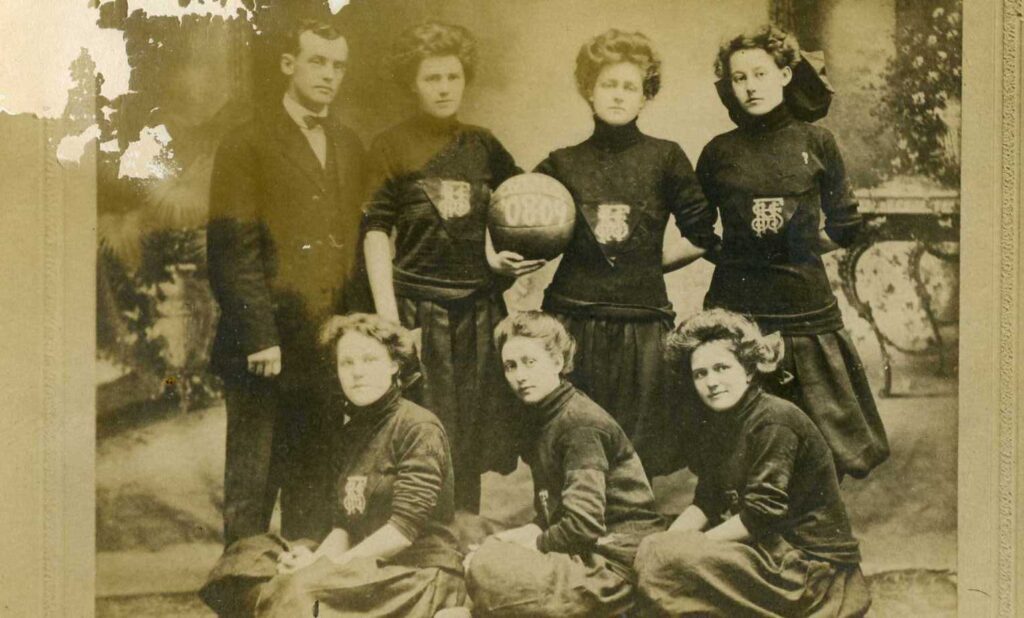
Canton High School
The 1908 Canton team won seven of the eight games they played. They concluded their season with a train trip to play games in Vermillion and Yankton. The Canton School Yearbook noted that after the Yankton game they were entertained at a private residence. They were scheduled to board a special freight train back to Canton at one A.M. However, the freight train was late and did not leave until eight A.M. the next morning. Elk Point was reached by the afternoon. They returned to Canton that evening.
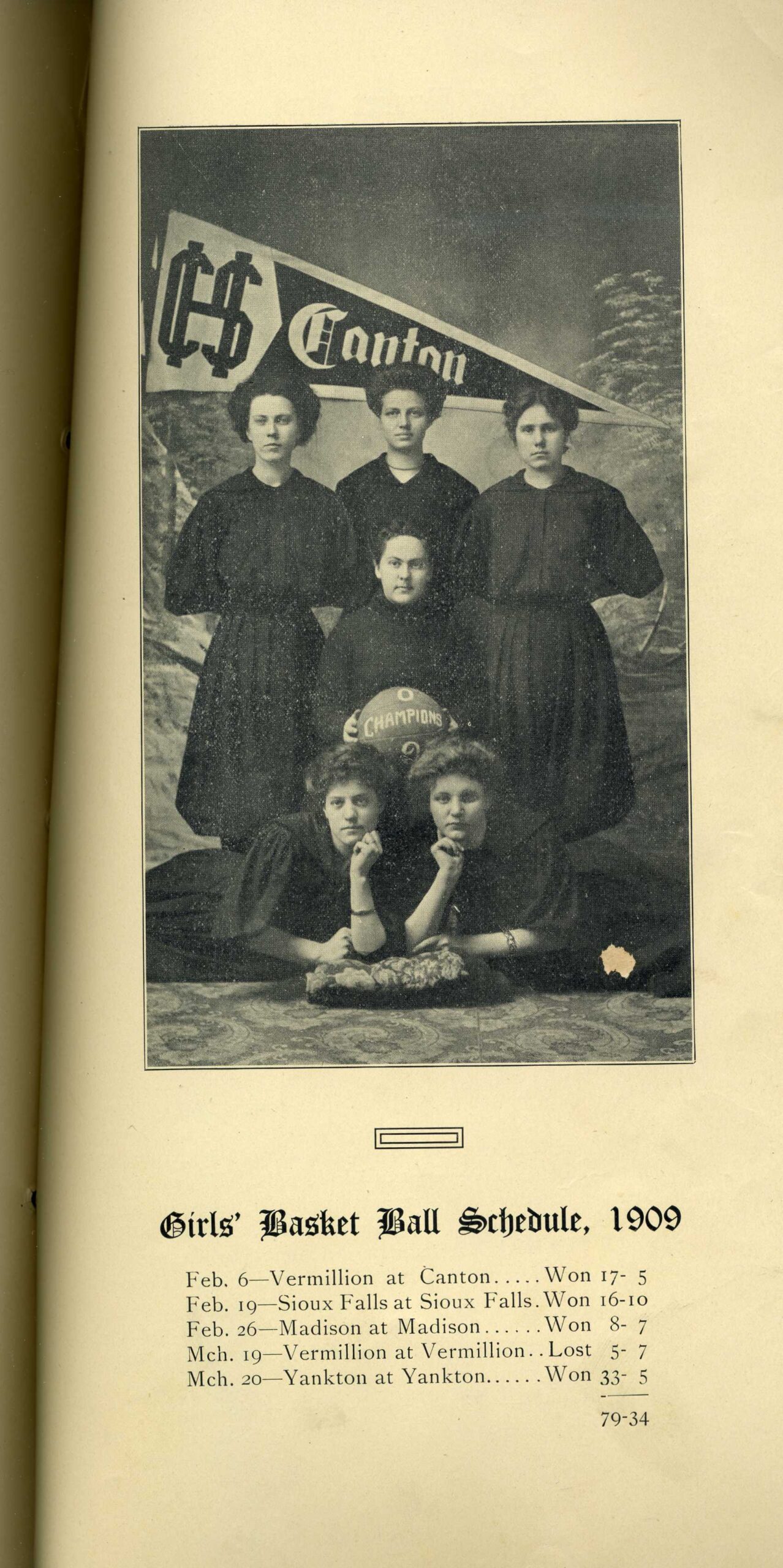
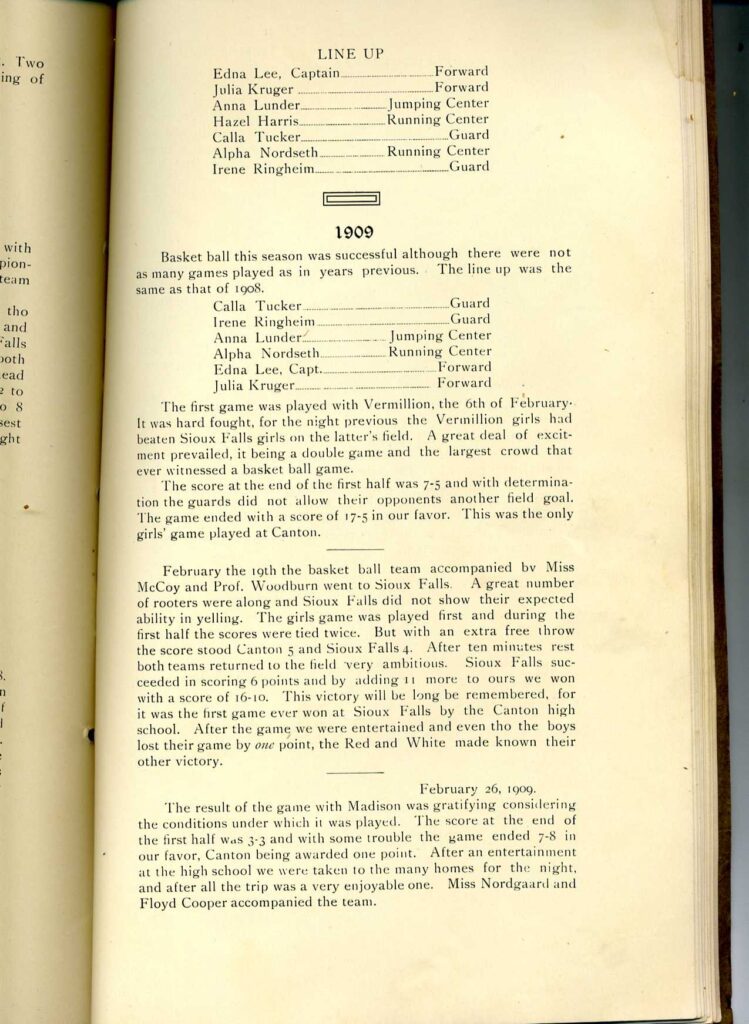
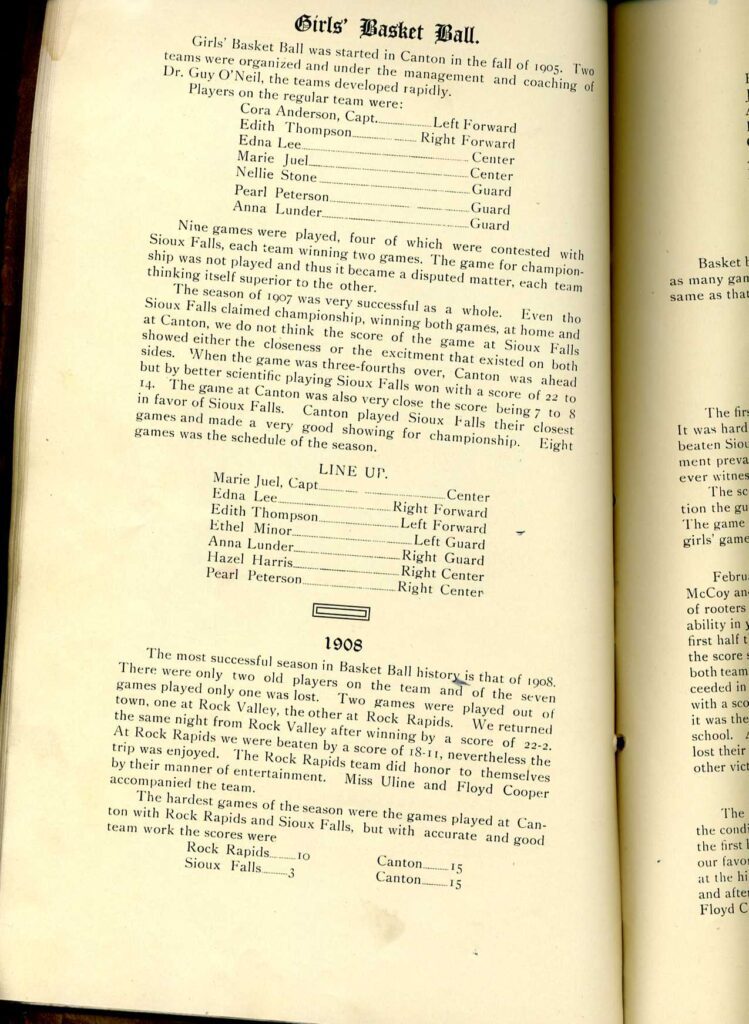
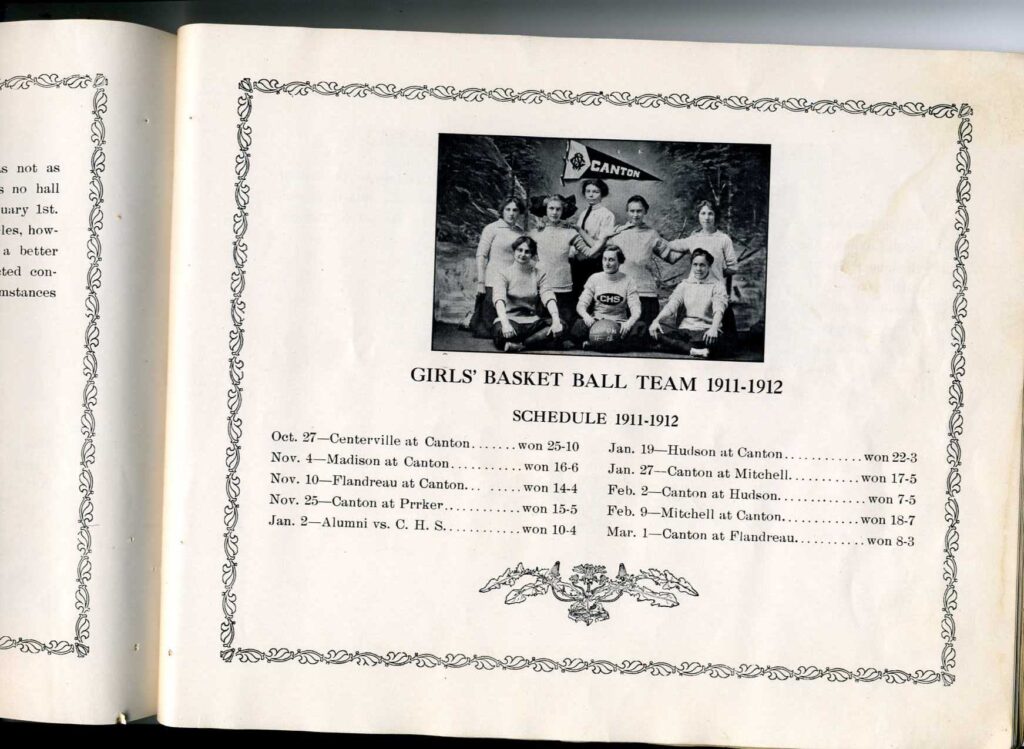
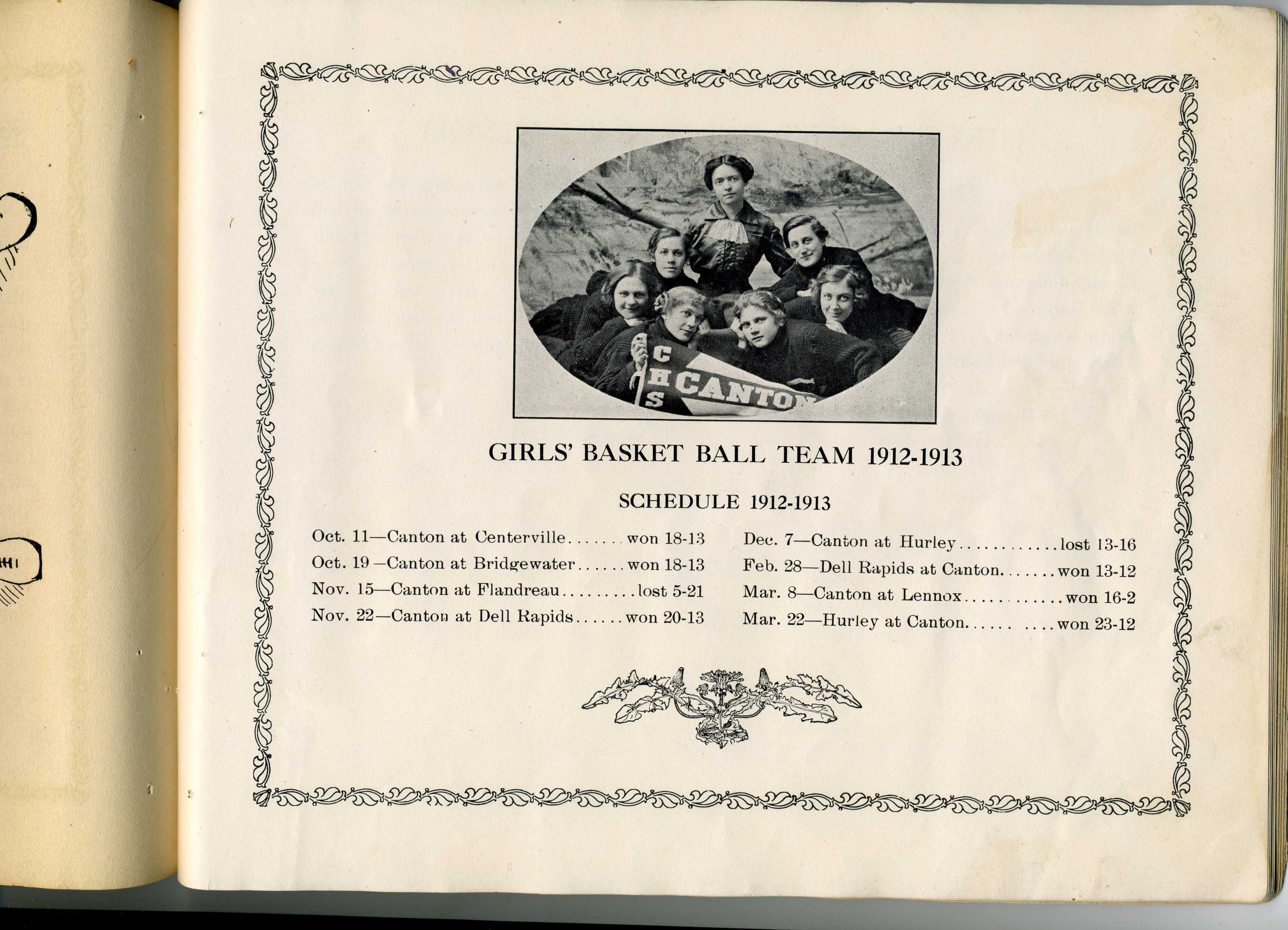
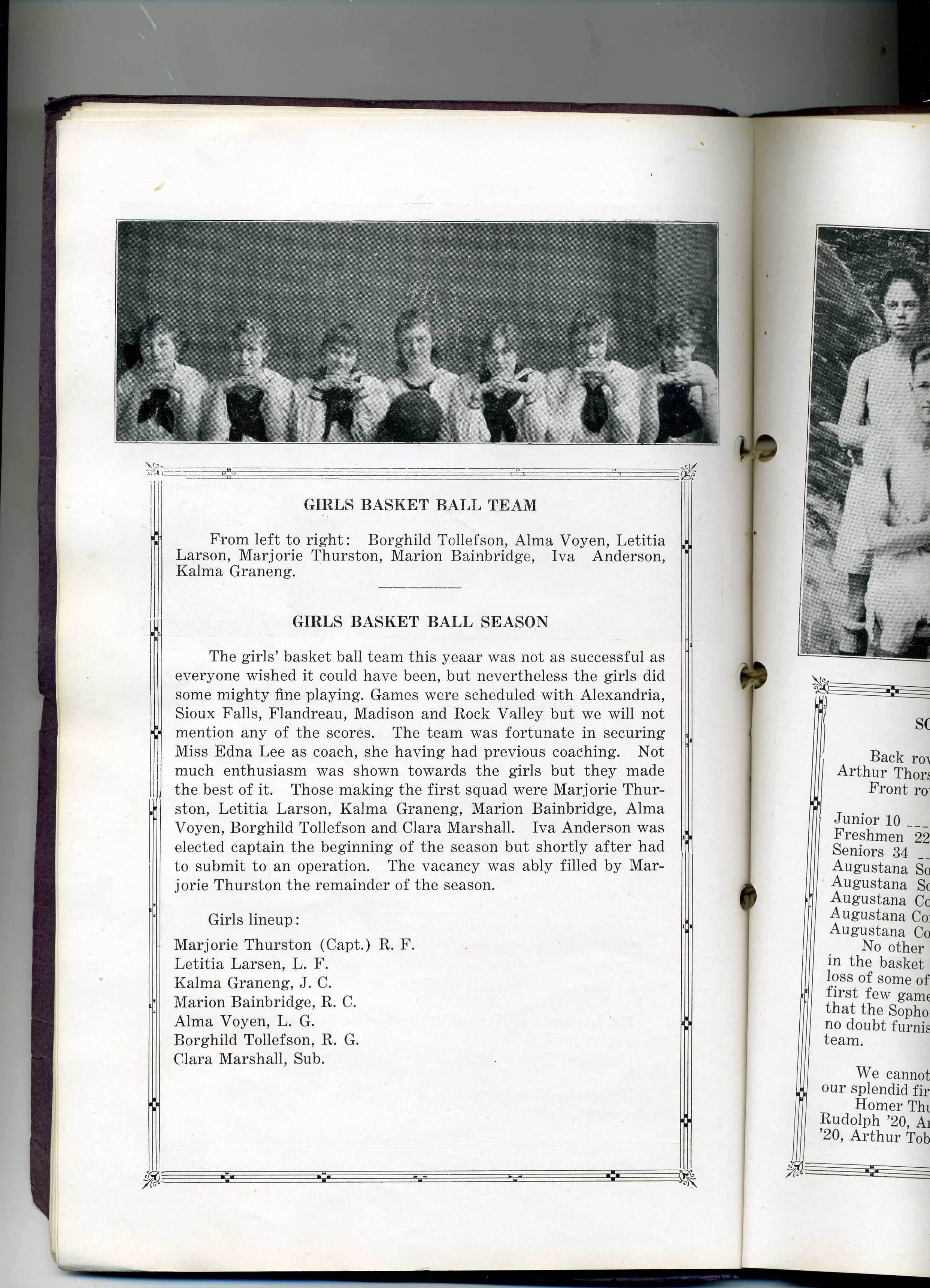
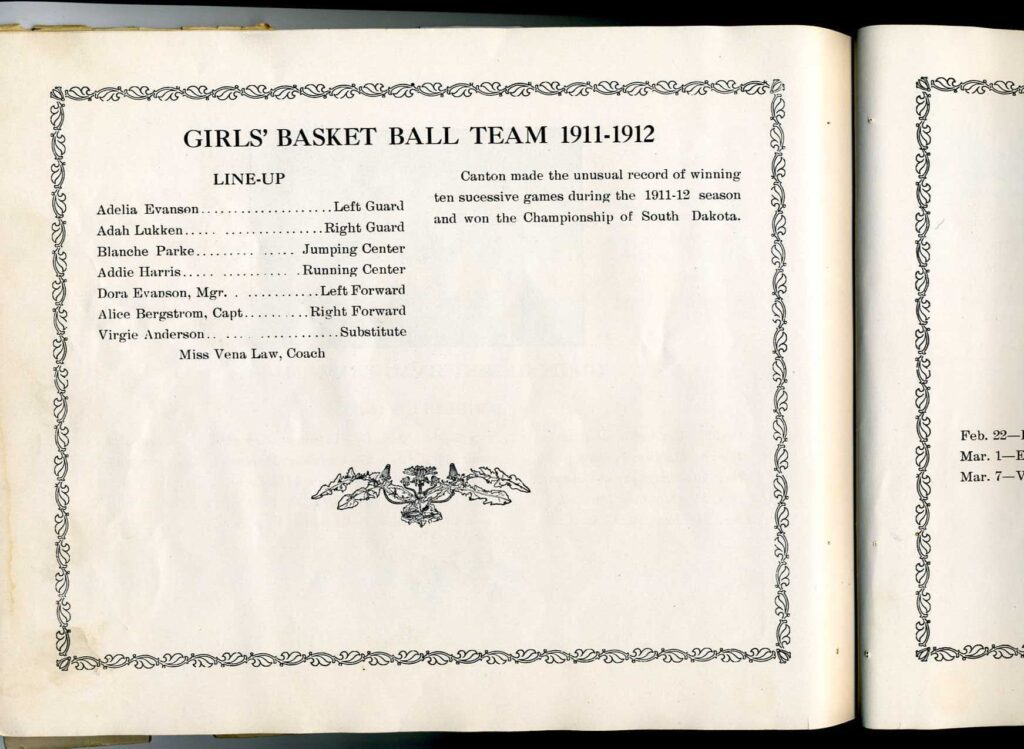

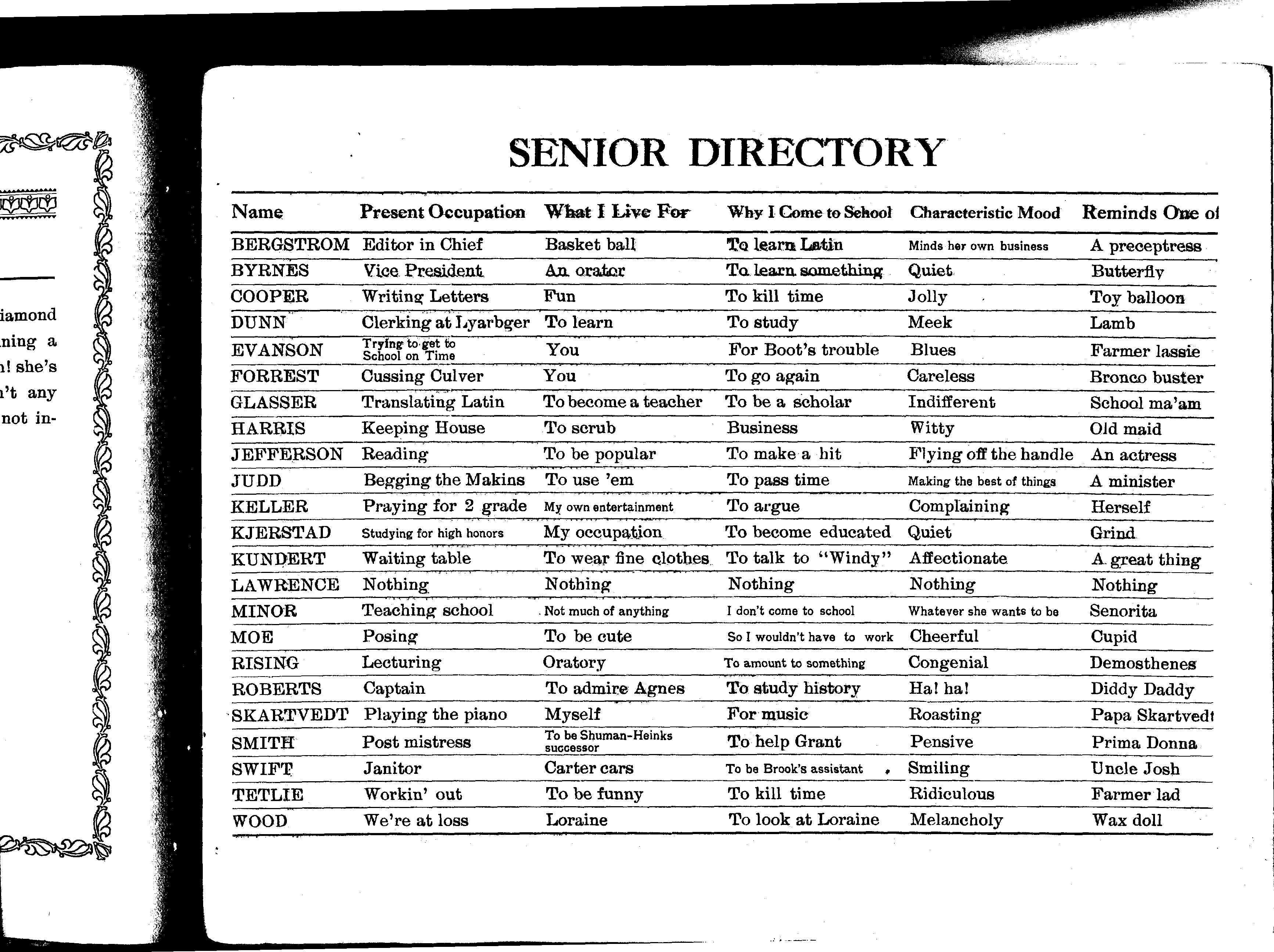

The Canton girls’ team of 1911-12 was their best team during this period. Canton won all twelve games that they played. They claimed the Championship of South Dakota at the end of the season. In the school annual team captain, Alice Bergstrom was asked what she lived for. Her response was “Basket ball.”

In 1912 Huron College began an invitational boys’ basketball tournament which is considered the first state boys basketball tournament. Huron College sponsored the tournament through 1915. After the 1915 tournament Huron College approaches the South Dakota High School Athletic Association about the possibility of taking over the state boys tournament. The first boys state tournament operated by the South Dakota Athletic Association was held in March 1916.
Participation in girls’ basketball continued, as more schools began to play girls’ teams. ‘Championship’ games continued to be held each season. In 1916 Vermillion defeated Flandreau for the “mythical” championship.
Flandreau High School

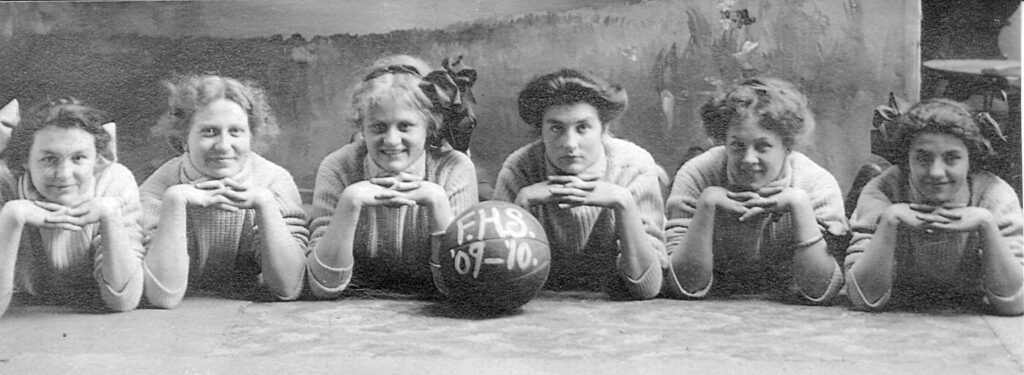
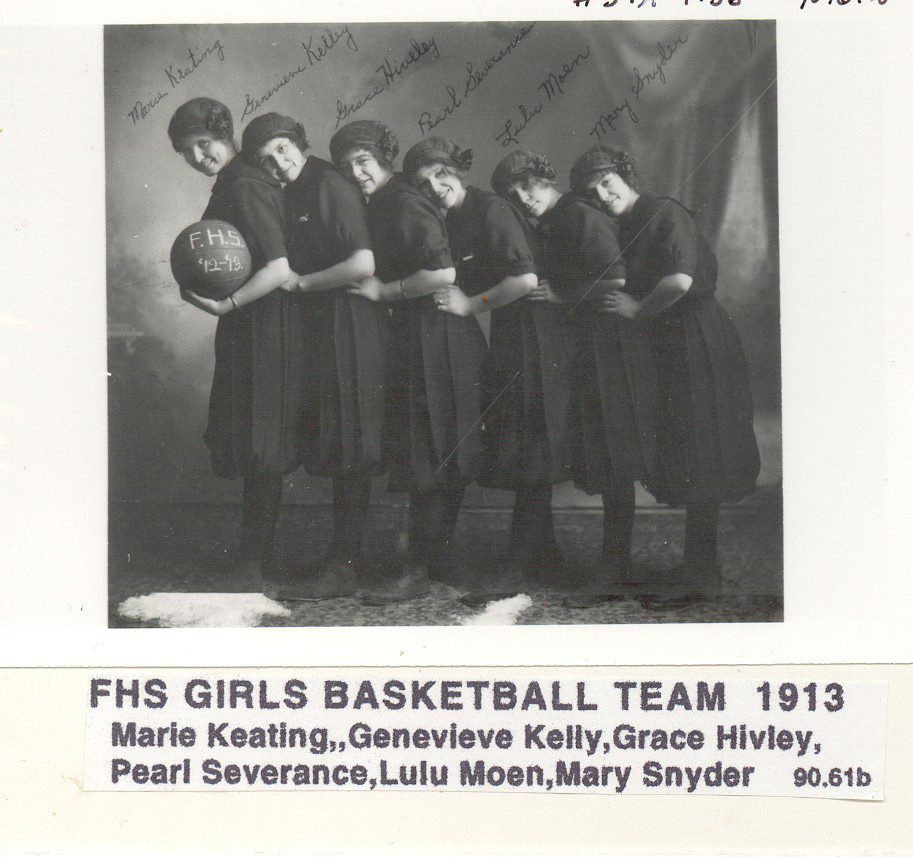
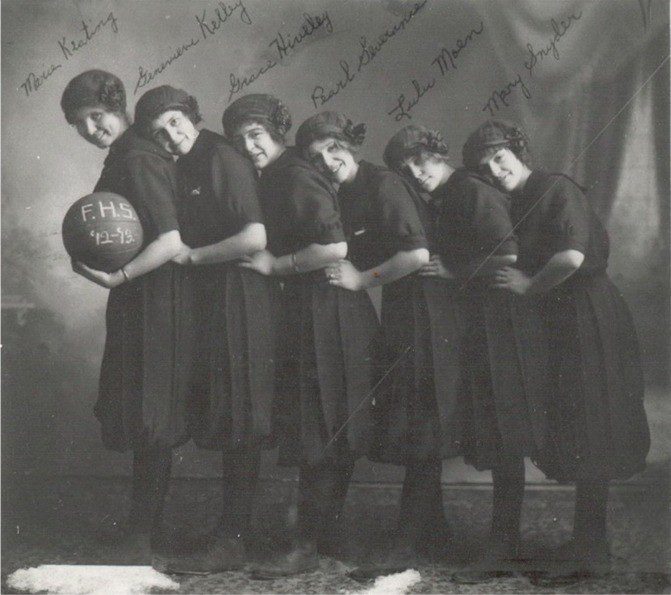

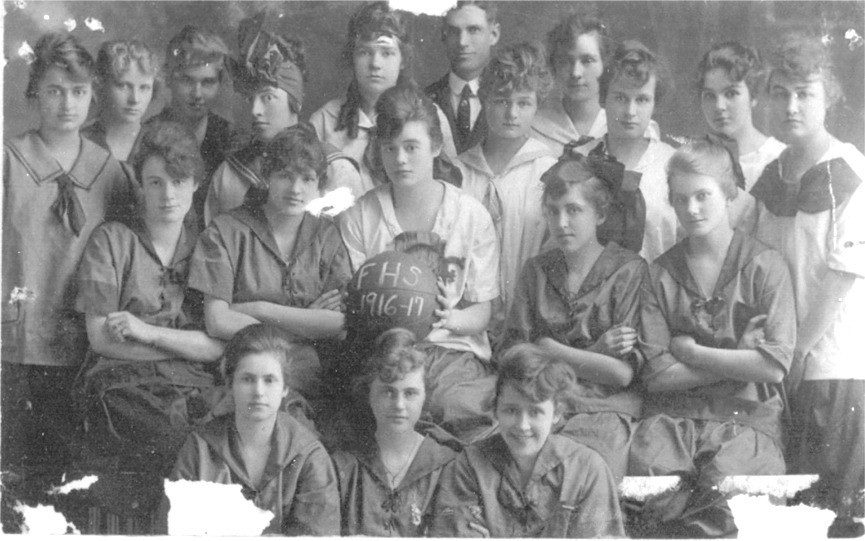
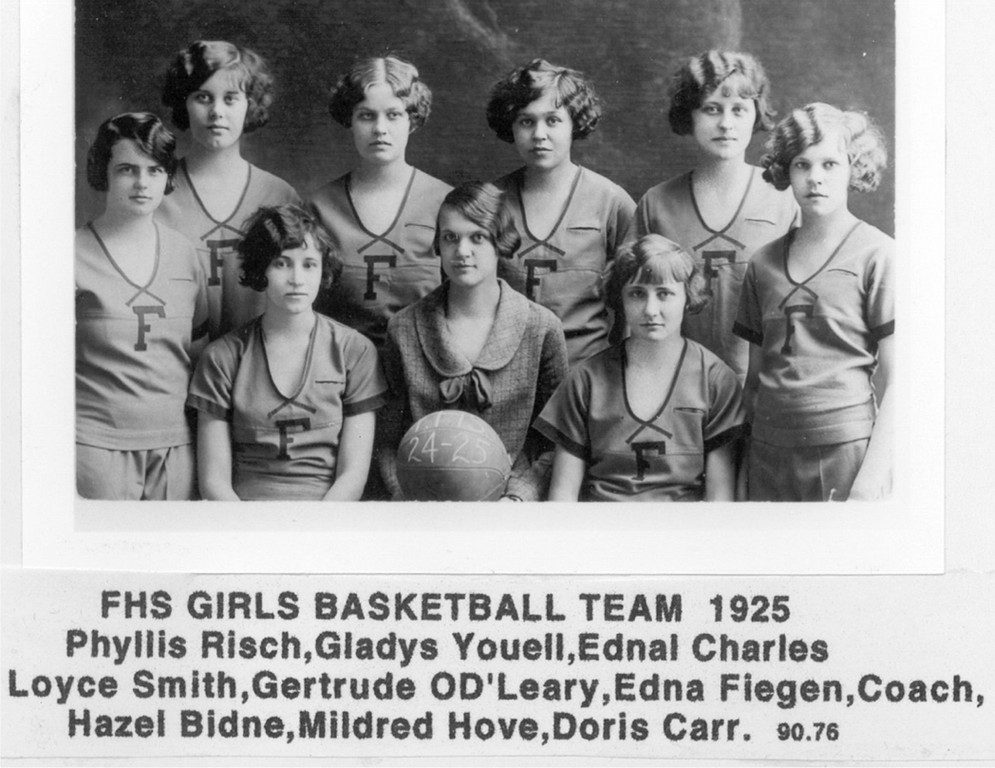
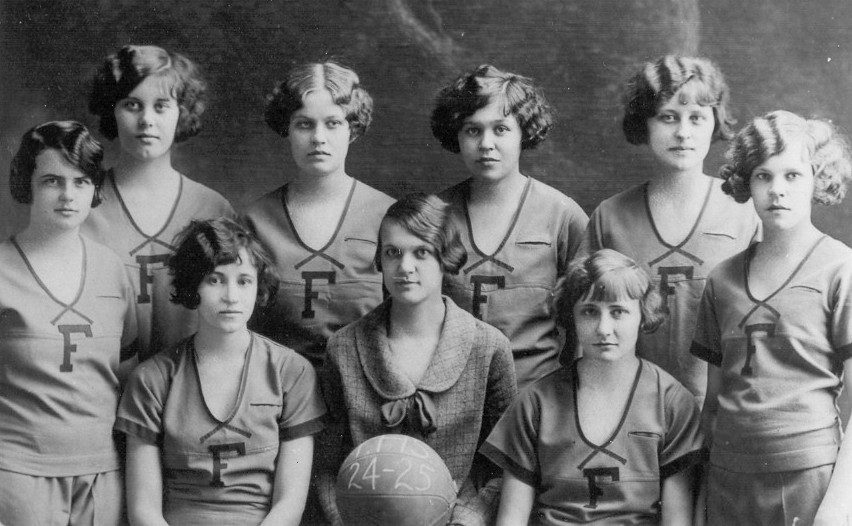
In 1920, following the end of World War I, there was extensive construction of new school buildings made with cement block and concrete. These new buildings included a new gymnasium area. This gym area created the environment where the individual schools could develop basketball programs. Perhaps nowhere in South Dakota did these new developments in school buildings and programs change a community than in the town of Java. Java is located near Selby, south and east of Mobridge in North central South Dakota. [ Java Girls 1921-
The Java girls’ basketball program began in 1920. Genevieve Fargen was the first coach at Java. The Java girls’ team initially practiced on a outdoor court, and played in the “old” theatre building. The 1920-21 team won all fifteen games they played. The victories included two wins over the Eureka Academy, a local college team.
Java High School
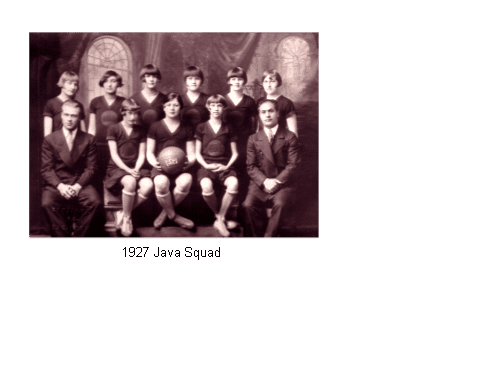
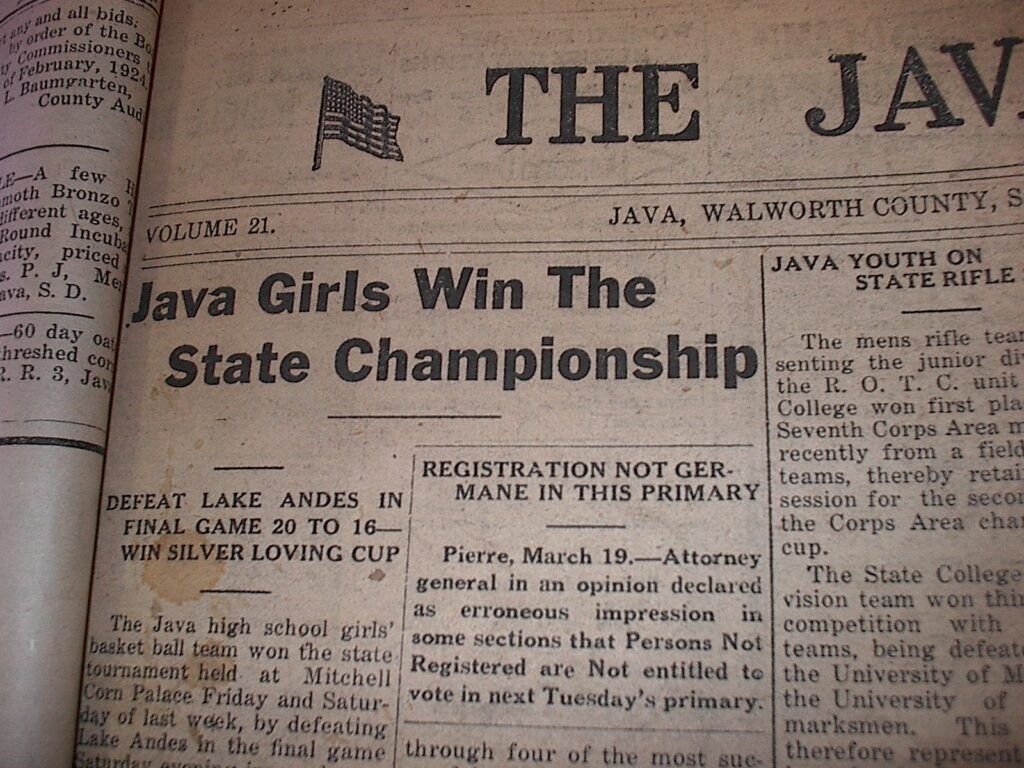
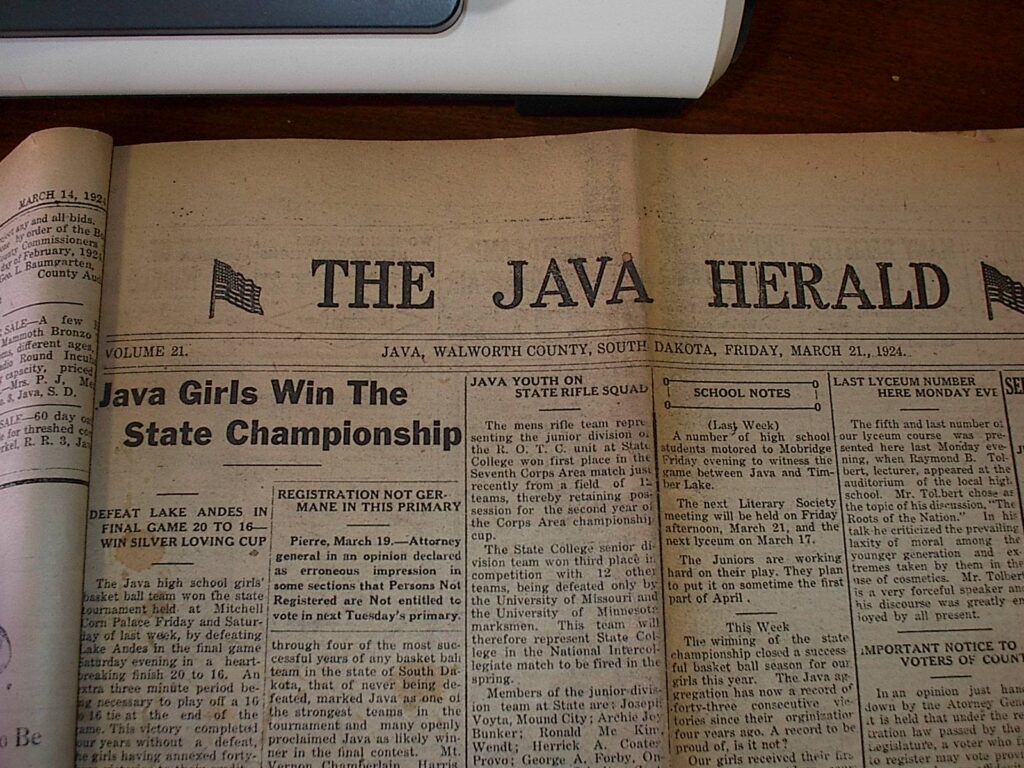



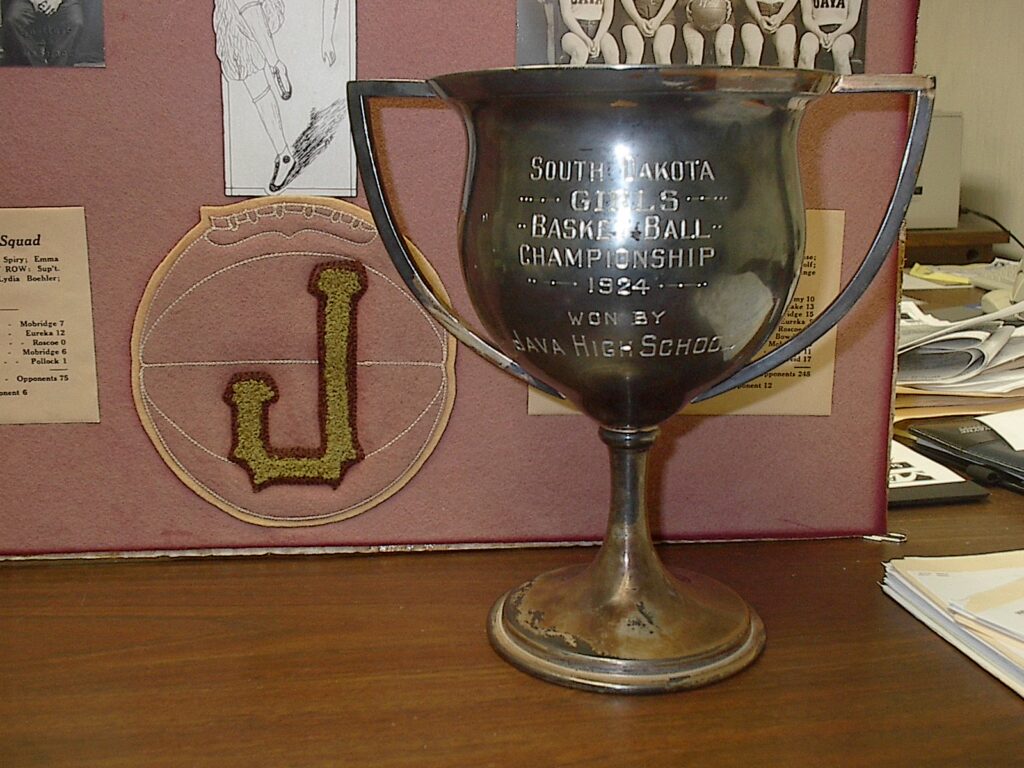

The Humboldt High School girls began the 1920-21 season by winning their first fifteen games. They began the season with wins over Salem, 53-2 and Colton, 51-8. They then defeated Canistota, 107-1. This was not the only time they reached one hundred points in a game. They defeated Harrisburg, 106-0. Humboldt defeated Lennox twice, 52-10 and 73-8. Humboldt defeated Sioux Falls Cathedral 40-14, and Flandreau, 44-21, one of only two times that season they allowed twenty points in a game. The season ended with a 33-24 win over Colton, and a stunning defeat against Flandreau, 19-11.
Humboldt Girls Basketball


.The Humboldt girls continued their winning ways during the 1921-22 season. In the second game of the season they defeated Garretson 32-6. The Hartford vs. Humboldt game drew so much attention that a special ‘freight’ train was arranged to transport the Hartford players and fans to the game. After the boys’ game was completed a community dance was held. The dance was to last until the special train arrived to transport the fans back to Hartford. However, the train did not arrive. The Humboldt Journal noted that the dance last until 2:30 in the morning. The special train did not arrive in Humboldt until 8 A.M., the next morning. The Hartford students and fans arrived back from the game a bit late. During the midseason the Humboldt girls were defeated by Garretson, 30-24. However, the Humboldt Journal noted that “the defeat was more or less a fluke and was played under rules of which the Humboldt girls were totally unfamiliar. In the final game of the season the Humboldt girls had a rematch with Garretson. A ‘special’ train was established to transport the Humboldt fans to the special event. The game was played at the Coliseum in Sioux Falls just before the finals of the boys’ district tournament. Humboldt was one of many high schools who staged ‘doubleheaders’ with both girls’ and boys’ games in the same evening.
After Humboldt’s victory over Garretson they laid a claim to the state championship trophy. However, their season was not finished. A game was scheduled in Sioux Falls on March 17, 1922, against the Gregory High School girls. The Sioux Falls Argus-Leader described the game in this manner,
” Displaying a remarkable floor game and basket shooting ability the Humboldt girls scored a decisive victory over the Gregory girls last evening, 34-9. The game was a preliminary to the consolation and championship finals of the state (boys’) tournament.
Inasmuch as Gregory held the west river championship, the game took the aspect of a state championship event and attracted a great deal of interest. It was indeed unique to bring a girls’ team all the way from the Rosebud for a game of this kind, and the enterprise was a credit to the tournament committee.”
Humboldt’s scoring leaders were forwards, Nettie Williams, with 21 points, and Dorothy Duncan with 13 points.
Java moved into the new and larger school gymnasium for the 1921-22 season. In January 1922 the girls’ team open the gym with a 51 to 5 victory over the girls from Cresbard. The Java girls’ team would go on to win the first fifty-four games they played.
Because of the severe weather during the 1921-22 season half of the Java girls’ games were cancelled, however they won all five games played. By the end of the season Java was claiming to be one of the outstanding teams in the state. They met a team from Carthage, in a special game at Northern State College in Aberdeen. Java defeated Carthage by the score of 32 to 2. Accounts from the Java newspaper describe the Carthage game as an attempt at determining a state “champion”.
In 1922-23 Java once again won all five of the games they played. The Java High School newspaper commented that they were only able to play five games because none of the surrounding schools were interested in playing the Java girls. Java defeated Mobridge, 29-1 and 50-1, and Ipswich, 16-1 and 33-6.
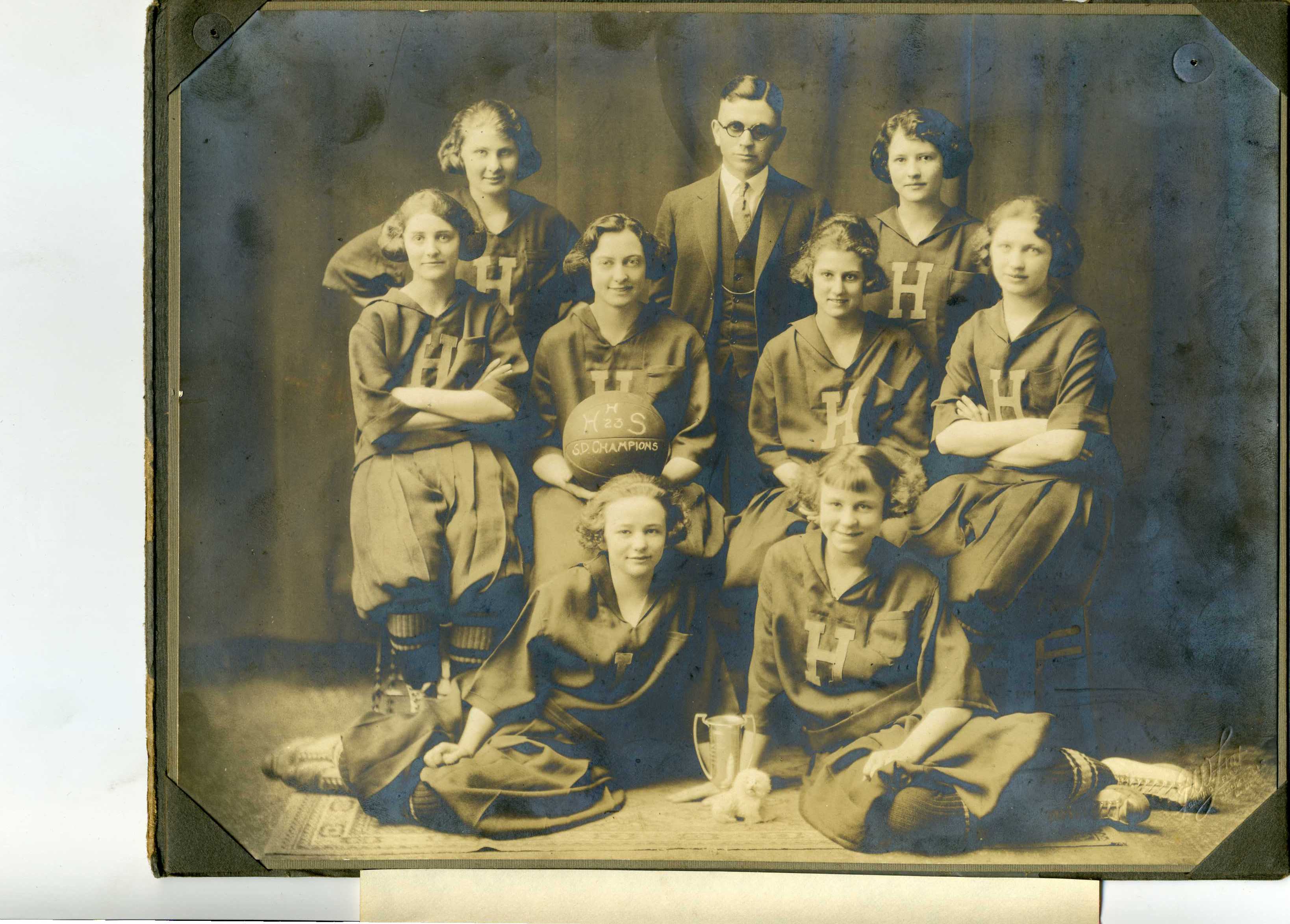
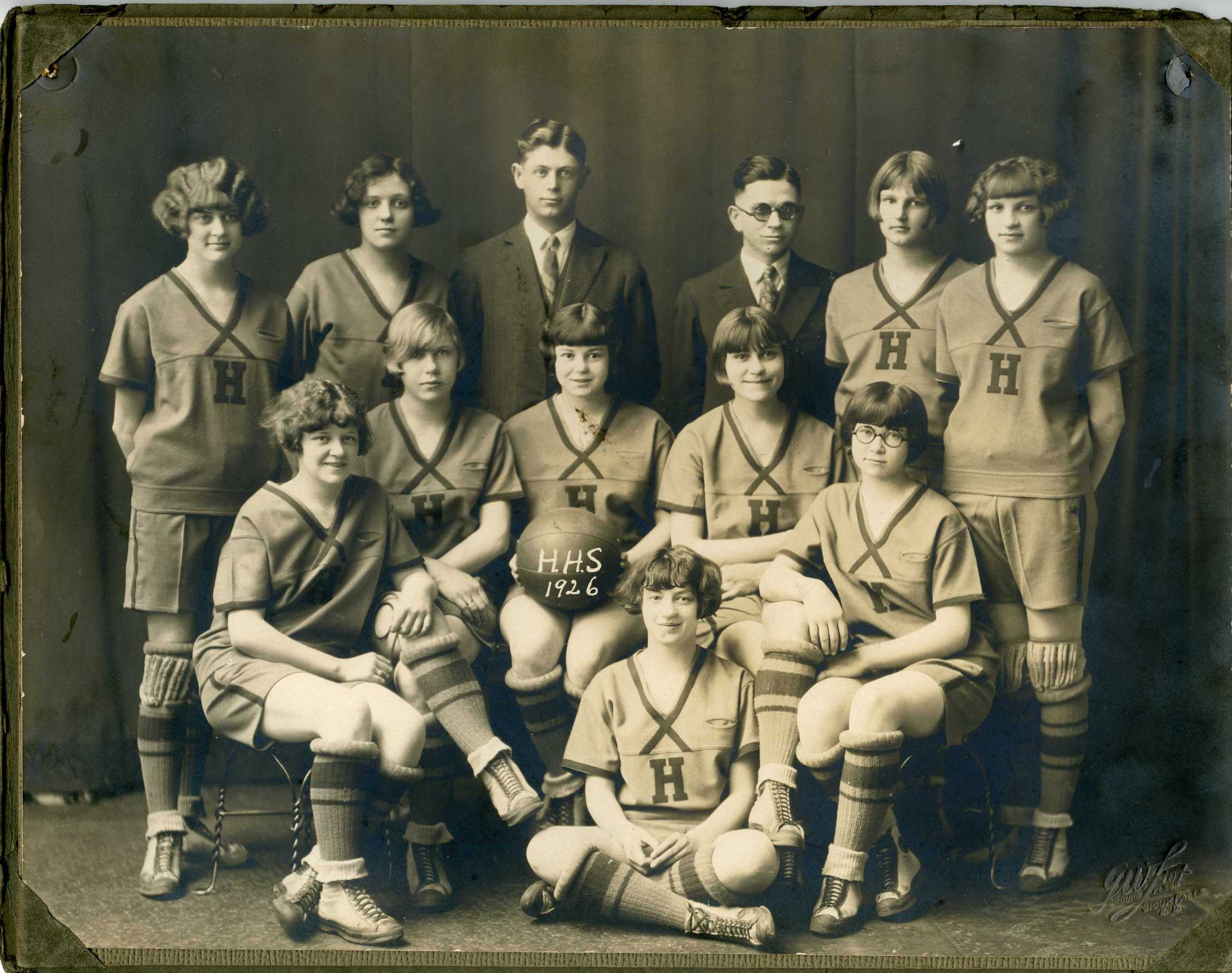
Humboldt completed the 1922-23 regular schedule on the first of March with a 11-1 record. At the end of March Dakota Wesleyan University organized an invitational tournament in which they hoped to determine a state girls’ champion. The intent of the Dakota Wesleyan athletic department was to develop a girl’s tournament, much like Huron College had done for the boys in the previous decade. However, several teams that were invited did not attend. Those taking part in the tournament were Humboldt, Plankinton, Spencer, Farmer, Scotland, Mt. Vernon, and Woonsocket. Humboldt won the invitational championship, winning three games in one day. Nettie Williams of Humboldt was selected the best all-around player, the high point getter for the tournament, and the top point getter for a single game. The Humboldt girls were awarded a silver cup for their championship.
During the 1922-23 school year a Sioux Falls girls’ city league was organized. The team at Sioux Falls High School was revived. Sioux Falls High School was undefeated in seven games. The city league was made up of teams from the Women’s Alliance, All Saints School, the YMCA, the Methodists, Sioux Falls College, Augustana College, and Sioux Falls Cathedral High School.

Sioux Falls city league games were played at the Germania Hall at 9th and Dakota Avenue in downtown Sioux Falls. The league was coordinated out the YWCA facility which was located a block east.
In 1924 Dakota Wesleyan once again sponsored a year end tournament. The tournament, at long last, gave twenty-four teams from throughout the state a chance to meet in a state championship. All of the tournament games held at the Mitchell Corn Palace were well attended.
The tournament began on a Friday morning. Alexandria won their Friday morning game over Farmer 10-6. Alexandria’s next opponent was Sioux Falls High School. The Sioux Falls High School team, coached by Pearl Anderberg, had won their seven regular season games. However, their coach, Pearl Anderberg was not permitted to attend the tournament. Milt Harvey, the Sioux Falls College coach, and city league coordinator, was selected to coach Sioux Falls at the State Tournament. In their first game Sioux Falls was defeated by Alexandria, 11-10.
The Saturday morning games began with Humboldt playing Lake Andes. Lake Andes defeated Humboldt by five points. The outstanding player of the game was Lake Andes’ freshman, Thelma Austin. Austin made eight baskets and two free throws. Parkston defeated Alexandria 29-14, as Adkins of Parkston scored twenty-four points. In the Saturday afternoon games, Java defeated Harrisburg, 27-7, and Spencer defeated Plankinton 25-17. In the semi-final games, Lake Andes beat Parkston 24-17, and Java defeated Plankinton, 18-14.
The championship game was a climatic finish to an exciting tournament. Java was undefeated, having won all of their nine regular season games. They had not lost a game in school history. The first quarter ended with Java up, 4-3. At the half Lake Andes led, 7-6. Lake Andes led by four points at the end of the third quarter. However, Java came from behind to win the tournament championship, 20-16. The Java girls received an eleven inch, engraved, gold cup [State Champs], and a $120 scholarship to Dakota Wesleyan University. Thelma Austin won prizes for scoring the most points in the tournament, 83 in five games, and the most points in a single game, 28.
The following year, 1924-25 Java won all five regular season games. Half of their games were cancelled because of the extreme weather conditions. Poor weather conditions prevented Java from traveling to the 1925 State Tournament to defend their title.
The 1924-25 Sioux Falls High School team won all of their city league games, giving them their third city league title in a row. The team was not allowed to travel out of town for games. This prevented Sioux Falls from entering the 1925 State Tournament.
On January 30, 1925, Flandreau challenged Lake Andes at Mitchell Corn Palace. Lake Andes won the special game.
Dakota Wesleyan once again sponsored the State Tournament. The 1925 invitational, State Tournament was held at the Lake Andes high school auditorium. Seventeen teams participated. They included teams from Flandreau, Lake Andes, Scotland, Murdo, Alexandria, Arlington, Spencer, Vienna, Highmore, Mt. Vernon, Fairfax, Chamberlain, Bridgewater, Geddes, and Nemo. Nemo traveled from the Black Hills to Lake Andes by train. The long train ride must have affected their performance, as they were defeated 43-1 by Flandreau. Flandreau was beaten by Lake Andes, who was led by their outstanding player, Thelma Austin. Lake Andes, the host team, won the championship over Scotland, 16-11. Thelma Austin scored 13 points for Lake Andes.
During the 1925-26 the Java girls won all ten regular season games. This brought their winning streak, from the first game they played in 1920, to fifty-four games.
The Sioux Falls city league was not organized for the 1925-26 season. Sioux Falls High School organized a team, but did not document their games. Sioux Falls did not have another girls’ basketball team until 1975.
The 1926 State Tournament was held at the Mitchell Corn Palace. For the fourth straight year Dakota Wesleyan University sponsored the State Tournament. The Mitchell Daily Republican co-sponsored the event. The tournament included teams from Java, Howard, Murdo, Farmer, Miller, Bridgewater, Platte, Herrick, Forestburg, Wagner, Ravinia, Geddes, Olivet, Humboldt, Plankinton, and Lake Andes.
Dakota Wesleyan University, Tumbleweed Annual
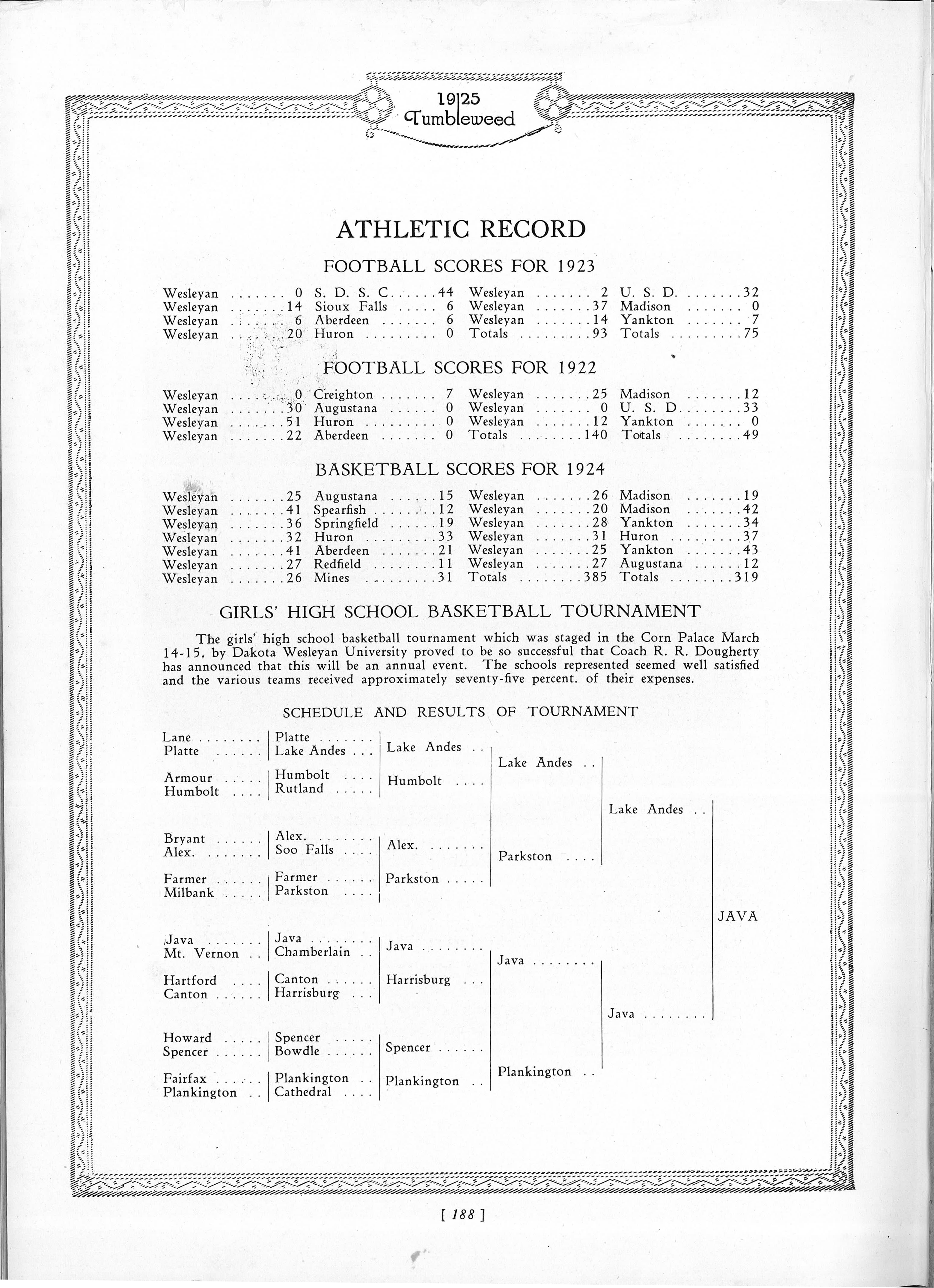
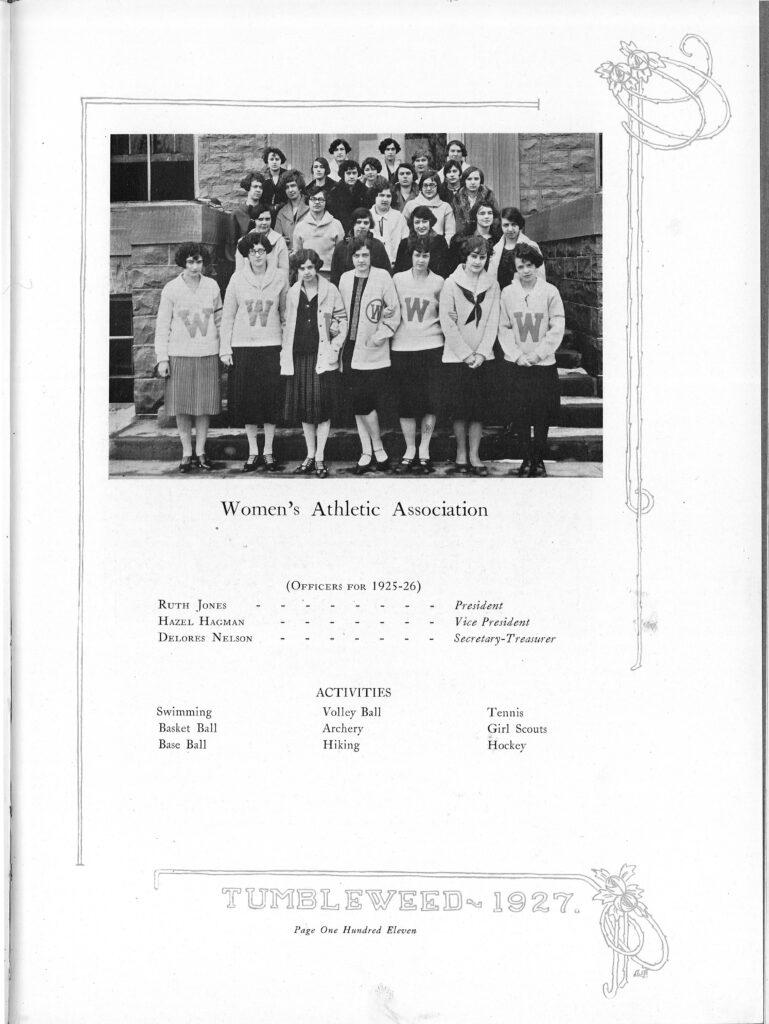
Java entered the tournament having not lost a game in six years. Murdo was also unbeaten for the season. There were several Charles Mix-Douglas basketball conference teams. Herrick had one loss on the season.
The Mitchell Daily Republican noted that:
“Periods in the first and second round games will be shortened in order that the endurance of the players will not be threatened for the semi-finals and finals competition.”
Invisible Lace Basketballs from Wilson and Company were provided for use during the girls invitational tournament.
Coaches included Gladys Dowdell of Forestburg and Wealthy Ann McGregor of Lake Andes. Thelma Austin was playing for Wagner during the 1925-26 season. Ravinia entered the tournament unbeaten.
Dr. Edith M. Shank, made “rigid examinations of all of the girl players entered in the tournament. Many of the team’s brought with them physicians’ certificates, but Dr. Shank is making individual examinations of all players. One one girl, however, has been barred from play thus far.”
Java was defeated by Howard, 15 to 9 in the opening game. This was Java’s first loss in six years. Java later loss a consolation game to Plankinton. Howard had lost only two games in the last two years. Wagner, led by Thelma Austin, defeated Howard, 22-20 in the finals.

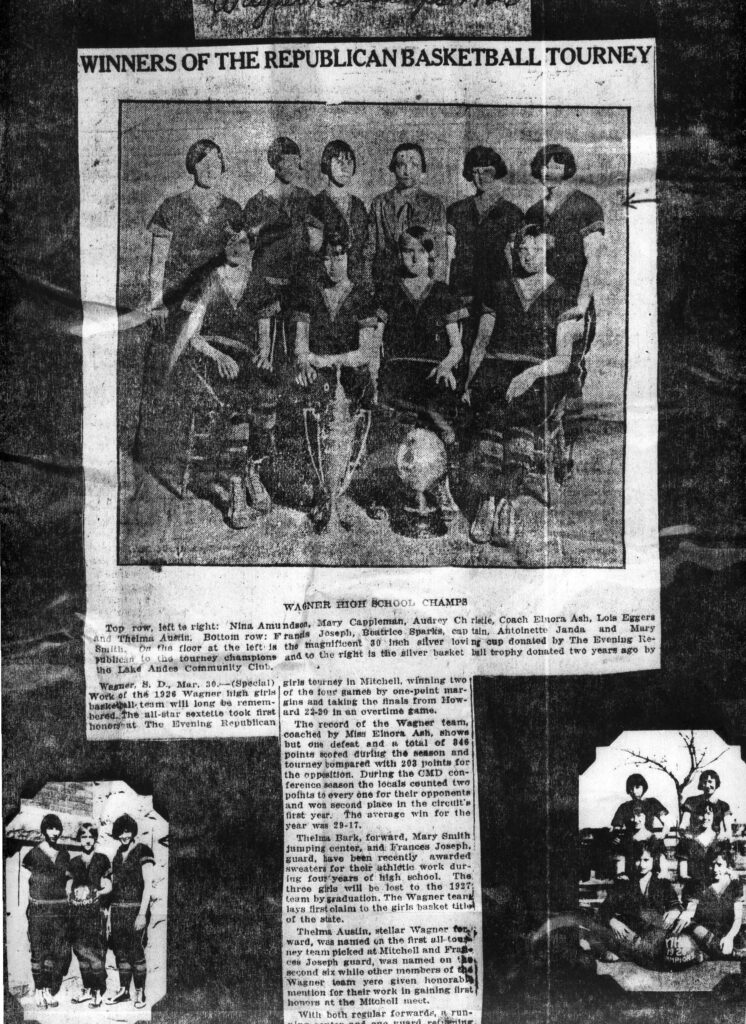

The South Dakota Athletic Association Handbook, 1927 noted that: In all girls’ basketball games Spalding’s Girls Basketball Rules shall be strictly adhered to:”
The South Dakota High School Athletics Association would take formal action during the fall which would affect girls’ basketball for the next fifty years. At their annual meeting on November 23, 1926 in Sioux Falls, the Board of Control took the following actions:
The Board initially proposed a committee be appointed to make a national study of the question of girls’ basketball participation. The Board of Control then decided not to sanction any girls’ basketball tournament unless sponsored by a member school. This eliminated sponsorship by a college such as Dakota Wesleyan University. After further discussion a motion proposed by Superintendent White of Deadwood was passed that the Board of Control do not sanction any basketball tournaments for girls. The motion was passed with three dissenting votes. The previous motion to limit sponsorship to a member school was withdrawn.
The SDHSAA Handbook of 1934 specified other limitations on girls’ basketball participation.
It was recommended that only women coaches be employed to coach girls’ basketball.
Inter school girls’ athletic contests were allowed. The matter was left entirely up to the local school district. A GAA league was organized at S. F. Washington. The North Central Association of Secondary Schools recommend that its member schools do not participate in any form of girls’ interschool basketball games or tournaments. No girls’ basketball tournaments could be approved by the Board of Control. Girls’ track meets could not have more than two schools competing.
Girls’ exhibition games were not allowed to be held in conjunction with a boys’ basketball game.
Many schools in South Dakota continued with their basketball programs for the 1926-27 season. The Java girls continued their winning ways. They won all thirteen of their games, including wins over Pollock, 58-1 and 70-1. At the season’s end the 1926-27 team was compared to the 1924 State Championship team in terms of outstanding performance and dominance. There was no year-end girls’ State Tournament held in March of 1927. With the limitations set by the Board of Control and the departure of Dakota Wesleyan University athletic director, Bud Dougherty, Dakota Wesleyan University chose not to sponsor a tournament. The Java girls’ won fifty eight of the sixty games they played from 1920-21 through 1926-27.
In April of 1927 the Java High School newspaper, the Maroon & Gold News noted that “drastic changes” had been made in girls’ basketball rules. The Basketball Rules Committee established that,
” No more will a clever dribbler monopolize the play, for the new rules limit the dribble to one bounce. Heretofore the number of bounces has been unlimited.”
The News stated that:
“The change was made to eliminate roughness and to promote team play. It has been estimated that seventy per cent of all fouls and violations of the rules are resultant from the dribble.
Hereafter “time out” will be taken on all fouls, and as a consequence the play will be stretched from three to five minutes. Previously “time out” was taken only on technical fouls or multiple personal fouls.
A third change forbids the referee to blow the whistle on jump balls except at the beginning of periods and after “time out”. Heretofore the whistle had sounded after each basket and added considerably to the confusion of a hot game.”
The Java girls’ and boys’ teams continued to play “twin bills” with neighboring teams during the 1927-28 season. In spite of the limitations established concerning dribbling the Java girls’ continued to put points on the board. Java defeated Glenham 71-3. “Gerry” Krause of Java scored forty-eight of the points making twenty-four field goals.
The Java girls’ lost their first game of the 1930-31 season to Herried, 11-9.
Sioux Falls Cathedral Girls 1921-1929
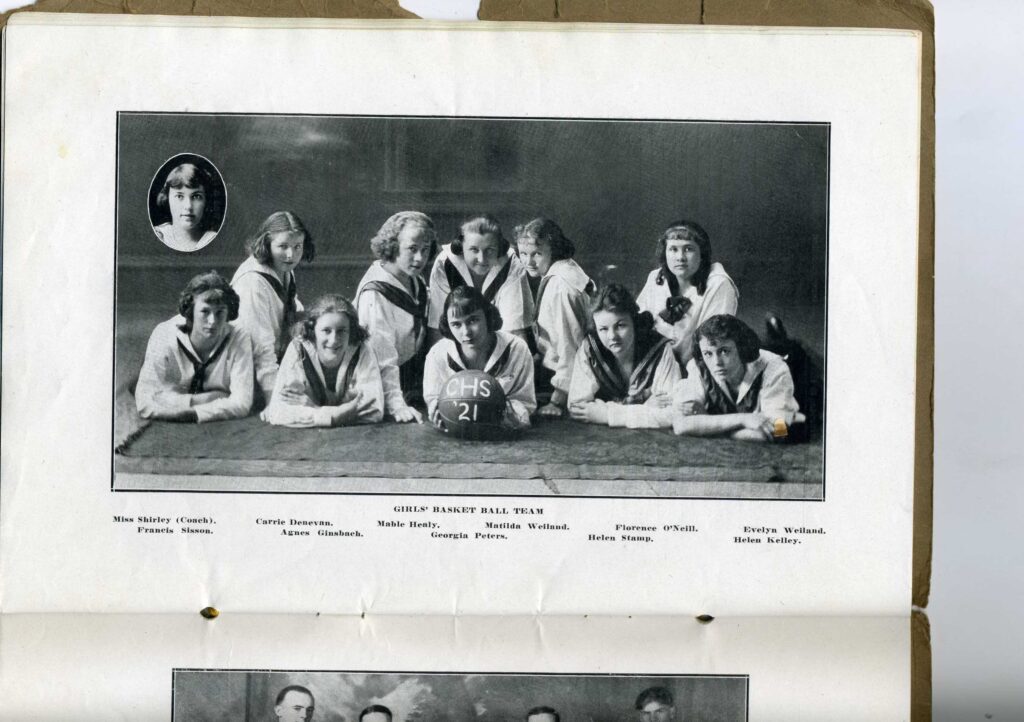

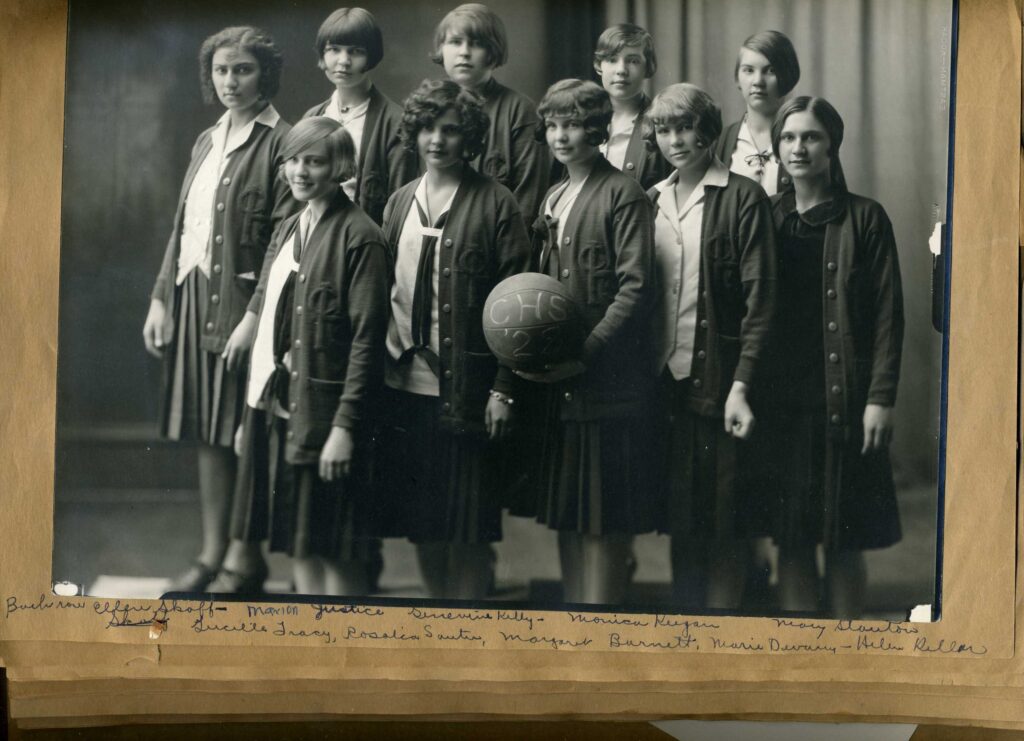

Girls’ teams at schools that were not members of the Athletic Association, such as Sioux Falls Cathedral and the Catholic Indian mission schools, Stephan, Holy Rosary, St. Francis, and Marty continued to have girls’ basketball teams.
Catherine Drexel chose to finance basketball programs at the various Catholic Indian mission schools, because she believed that basketball was an inexpensive sport that could be financially feasible at the mission schools.
Thelma Austin Smalley, who led Lake Andes to the 1925 State Championship moved to Wagner in 1926, and led Wagner to the 1926 State Championship. Thelma was honored at the 1980 State Girls Championship in Huron. Austin Smalley was living in Everett, Washington at the time.
The Java girls, many of whom were in their 90’s, returned to the Java All School reunion in the mid-1990s. We can only wish that they would have been interviewed more extensively.
You just wonder about the high school superintendents and administrators throughout South Dakota. Many of the students in the several new high schools that had sprung throughout the state were girls. Athletics was an integral component of the “classic” educational experience that the administrator learned about in their higher education training. The girls had seized the opportunity to participate in athletic contests when given the chance. They had been involved with this endeavor with such enthusiasm. The players developed their skills. The teams were organized and displayed remarkable teamwork and ability. You had a decade, after the main school facilities were created, to allow for basketball competition throughout the region. What do you do? Make every attempt to kill off girls’ basketball competition.
Marian Devitt, an excellent South Dakota historian, was the one of the best pitchers for the Irish farm community in Lincoln County. She still pitched at the Devitt/Hurley family picnics in the 1950s. She had to spend her long teaching career in South Dakota, knowing that she was a very good athlete. Marian spent decades developing girls’ athletes who were not given the opportunity to display their athletic abilities. It would be interesting to ask Marian about this, at this time. She would have given you that very patient smile. She would not have been able to coverup completely the true feelings about the matter. Where did the women athletes get all that patience to handle the years of frustration?
Look at photo of the girls from the Dakota Wesleyan University Athletic Association from 1926, the year the State Athletic Association voted to end the girls’ tournaments in South Dakota and adopted the restrictions on play purposed on the national level by the Amateur Athletic Union. You look how they proudly wore the athletic “letter” sweaters. Letters they had won for the outstanding athletic performances. Many of these women would become young teachers, beginning long careers educating the children of South Dakota.
